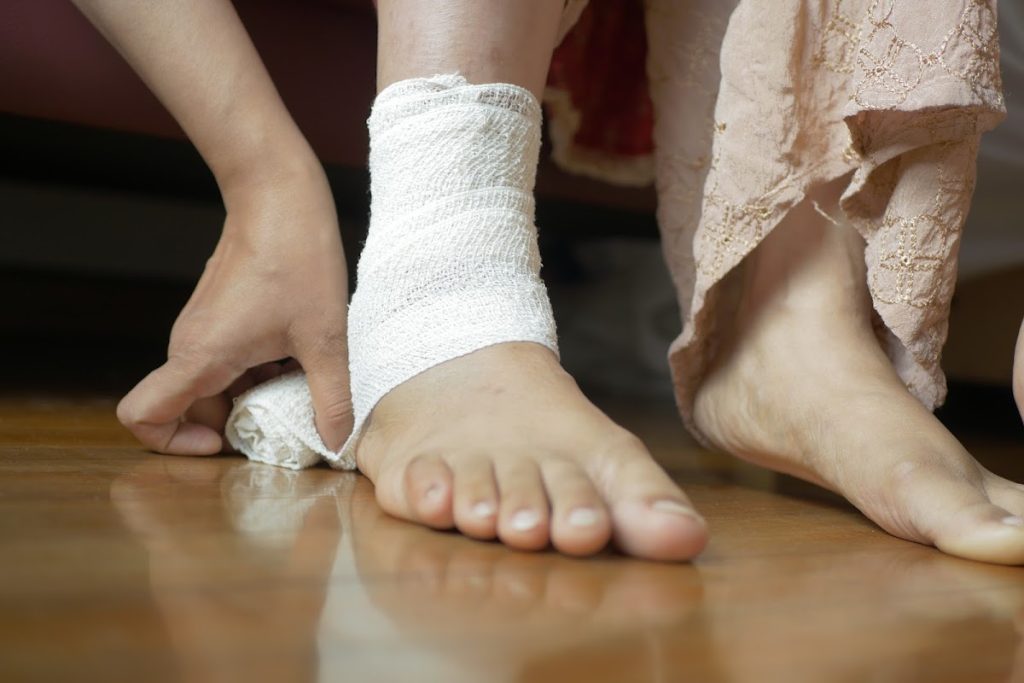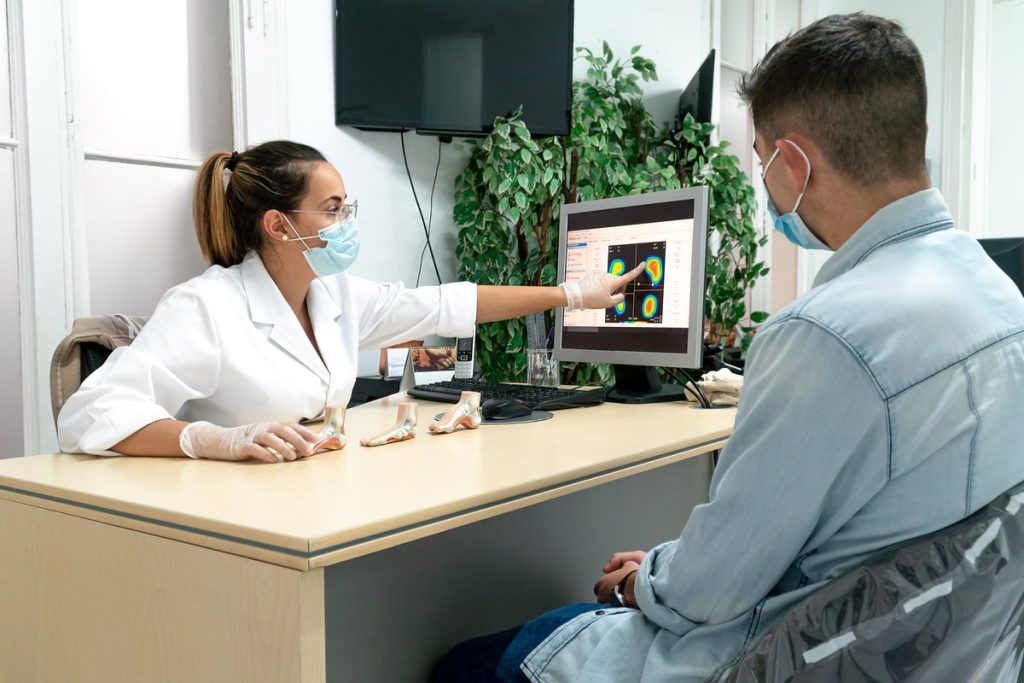Gout is a type of arthritis characterized by severe aching and redness. It often attacks the ankle, limiting mobility and affecting lifestyle. Since gout dates back to ancient times, modern life habits have made it increasingly prevalent. Understanding its symptoms and causes is a necessary step toward effective treatment.
Southernmost Foot and Ankle Specialists will only stop at something to deliver comprehensive solutions for those aching ankle woes. This article will demystify gout in the ankle from its sharp beginnings to the relief and control possible with expert care. Stick with us as we take a journey along the path to reclaiming your foot freedom.
 Understanding Gout — Ankle Gout And Gout In The Joint Areas
Understanding Gout — Ankle Gout And Gout In The Joint Areas
Gout is a form of arthritis characterized by sudden attacks of joint pain, swelling, redness, and tenderness. The big toe is most commonly affected, although gout can often affect the ankle joint. The symptoms result from accumulating urate crystals within the affected joint, leading to severe inflammation and discomfort.
What Causes Gout?
The cause of gout in the ankle-or any joint-lies in elevated blood levels of uric acid. Uric acid is a metabolic by-product produced by the breakdown of purines, substances found naturally in the body, and certain foods. Under normal conditions, uric acid dissolves in the blood, moves through the kidneys, and is excreted in the urine. But if the body produces too much uric acid or doesn’t excrete enough of it, uric acid can build up and crystallize in a joint or the tissue around it, leading to an encounter with gout.
Why The Ankle?
Gout attacks occur in the ankle, a weight-bearing joint usually with increased uric acid crystal deposits. Low temperatures in the peripheries or extremities, such as the ankles, may support crystal formation more than in the rest of the body.
Lifestyle And Medical Conditions
Various factors can contribute to high levels of uric acid and, correspondingly, crystalline buildup of uric acid: a diet with high purine intake, such as red meat and seafood; excessive alcohol intake; obesity; hypertension; and medications or medical conditions.
Understanding these dynamics can help prevent and manage gouty attacks at the ankle, reducing their frequency and severity. The sections below provide more information on the best ways to treat and manage gout at the ankle.
Symptoms Of Gout In The Ankle
Gout is a form of excruciating arthritis characterized by intense pain that happens rather suddenly. Though primarily noted to attack the big toe, it is not so nice to the ankle joint. Symptom identification will help in pursuing early treatment to evade further joint damage.
- Intense Joint Pain: The most characteristic symptom of an acute gout attack is severe pain in the involved joint that develops abruptly, often during nighttime and peaks in 12 to 24 hours.
- Lingering Discomfort: Several days after the extreme pain has passed, some discomfort and inflammation may persist. Sufferers report a sensitive ankle that persists for days or weeks.
- Swelling and inflammation: It can cause the ankle to swell, feel hot, and look red; this is a cardinal sign that something is amiss and needs attention.
- Loss of Range of Motion: A gout attack diminishes one’s ability to move the ankle joint, which may hinder one from performing simple activities.
These are the gout symptoms in your ankle that you must not neglect because neglecting them will lead to chronic gout with increasing frequency of flare-ups and fluctuating intensity. Prompt action when you encounter any of these symptoms- including applying a worthy remedy, seeking a proper diagnosis of gout, and searching for various ways of treatment symptoms can be considerably managed, and further attacks can be prevented.
They should be exceptionally watchful if there is a family medical history or predisposing factors to the condition, such as elevated uric acid levels. Early diagnosis and structured treatment programs that may include treatment and lifestyle modification can manage ankle gout and prevent gout attacks about fourfold. Watch out for these warning signs and take matters into your own hands regarding your joint health and general well-being. Continue reading to understand the best ankle gout treatment options available and how to relieve pain and inflammation.
Causes and Risk Factors
Ankle gout strikes when the sensitive balance inside your body goes off kilter, causing uric acid to build up in both the body and some of the food you eat. If uric acid levels go through the roof, the risk of a gout attack in the ankle or any other joint increases astronomically. A deeper understanding of the causes and risk factors may give you an advantage against this painful condition.
- Excess of Uric Acid in the Blood: When your body produces too much uric acid or does not excrete it well, uric acid crystals start to develop. Thus, an attack of gout may be created in the ankle and sometimes in the big toe. This accumulation of uric acid is the chief cause of unbearable pain and inflammation during a gout attack.
- Nutritional Factors: A diet high in foods that contain a high amount of purines can elevate uric acid levels. Examples are red meat, seafood, alcoholic drinks, and fructose-sweetened drinks. These should be consumed in moderation so that uric acid levels remain optimal.
- Obesity: While excess weight increases the load on your joints, obesity can also increase uric acid levels, increasing susceptibility to gout.
- Medical Conditions: Diseases like high blood pressure, diabetes, and kidney disease reduce the body’s ability to eliminate uric acid, which may cause gout.
- Family History Genetics: plays a part in gout. If your family history includes gout, you are at an increased risk of experiencing it.
- Age and Gender Considerations: Gout is more common in men than in women and affects adults more than younger individuals because of the varying levels of hormones influencing uric acid removal.
Knowing this becomes relevant to managing and preventing gouty attacks in the ankle. By being aware of what sets off gout and how it works, lifestyle changes and treatments can be resorted to that attack its roots, limiting the occurrence of flare-ups of gout and protecting the joints.
Effective Treatment Options
Timely and appropriate intervention is critical to successfully managing gout in the ankle. The mainstays of treatment for gout are to reduce pain and inflammation during an acute attack and prevent future flare-ups, thus protecting your joints from future damage. Here is how best to address this type of arthritis, which involves the sudden development of solid pain.
Medications:
- NSAIDs, or nonsteroidal anti-inflammatory drugs: These are the first line of defense against the swelling and discomfort caused by a gout flare. They reduce inflammation, which is how they work to manage acute gout symptoms of the ankle quickly.
- Colchicine: This is quite effective, especially during an acute gout attack. Once taken at the onset of gout symptoms, it relieves pain in the affected joint and helps prevent further attacks.
- Corticosteroids: These are given to patients who cannot tolerate NSAIDs or colchicine in an oral fashion or via injection directly into the afflicted joint. They work very well to diminish the painful inflammation.
- Lifestyle Changes: Along with medical treatment, lifestyle changes are also prescribed to manage gout in the ankle. Lifestyle modifications include maintaining weight, hydration, restriction of alcohol intake, and avoiding purine-rich food.
- Uric acid monitoring: You can avoid uric acid crystal buildup in joints through repeated monitoring and management of uric acid levels, thereby reducing the chance of gout attacks apart from causing joint damage.
People experiencing the symptoms of ankle gout should develop a treatment plan with the consultation of health professionals to ensure efficiency in the treatment. This will help improve the health of joints and bring in positive health conditioners, thus minimizing the complications resulting from untreated gout.
Lifestyle Changes And Home Remedies
Battling ankle gout requires a proactive approach beyond medication. This painful condition can be considerably soothed when you align your life with strategies to reduce uric acid levels. Here’s how you can keep the attacks of gout at bay and make sure your joints are healthy:
- Dietary Changes: Gradually move away from high-purine foods like red meat, seafood, and organic meats; this will significantly help. These foods tend to accumulate uric acid, which is the crystal responsible for ankle gout and other joints. Stress a healthy, well-rounded diet with fruits, vegetables, whole grains, and lean protein.
- Importance of Hydration: Drinking plenty of water is more than essential; it helps wash out uric acid and prevents the crystallization that leads to gout. Aim for at least eight glasses of water daily to keep uric acid levels under control.
- Alcohol and sweet drinks reduction: Alcoholic drinks, especially beer and sweet drinks, contain a higher amount of uric acid, which may lead to an increased risk of an attack. Reducing consumption will not only reduce the risk of developing gout in the big toe but also in all the other possible joint sites, including the ankle.
- Weight Control: Being overweight increases uric acid levels through heightened production and lessened elimination. Maintaining a healthy weight cuts down the amount of uric acid in the body and minimizes pressure from your joints, two crucial things in averting gout flare-ups in the ankle.
Such changes significantly improve the management of gout, so every step you take is without the excruciating pain of an affected joint.
Prevention Strategies
Prevention of ankle gout begins with making lifestyle choices to avoid uric acid build-up and ensure healthy joints. Here is a brief overview of ways to prevent the development of this painful disorder.
Summary Of Lifestyle Choices:
To control uric acid, try to follow a low-purine diet as much as possible. Keep yourself hydrated by drinking at least 8-10 glasses of water daily.
The best ways of preventing gout are through regular exercise to keep oneself at a very healthy weight and also reduction of alcohol and sweet drinks that raise uric acid levels.
Importance Of Regular Consultations:
Regular check-ups can detect early signs of uric acid build-up and allow the taking of preventive measures before it develops into an acute gout attack. Family history of gout makes all the above important.
When To Consult A Doctor:
Experiencing sudden and intense pain in the ankle joint, Ankle swelling, redness, or warmth.
- When to Seek Professional Medical Help: If the symptoms of ankle gout start to appear, consult with any healthcare provider immediately. The more immediate the diagnosis and treatment, the better, as this can greatly reduce pain and prevent joint damage.
 Importance Of Early Diagnosis And Treatment:
Importance Of Early Diagnosis And Treatment:
- An early treatment plan can manage symptoms and prevent future gout flare-ups.
- Treatment options for ankle gout are variable, and a healthcare provider will provide the best advice specific to your particular needs.
- Treatment may comprise pharmacological intervention, changes in lifestyle routine, or even aspiration of the joint to alleviate serious attacks.
Certain things need to be done in all aspects of life to help manage gout symptoms and take critical steps in preventing gout in the ankle. Awareness and proactive management are one’s best defenses against this form of arthritis, which causes sudden, severe attacks of pain and can lead to further joint damage if left untreated.
COMMITTED
TO EXCELLENT SERVICE
Our philosophy has been that the patient always comes first.
EMERGENCY OPERATOR
24 HOURS
Get emergency care from a specialist right from the start. Don’t go to an urgent care, ER or general doctor. Come straight the specialist.



